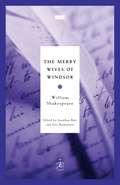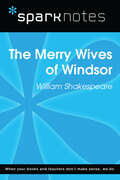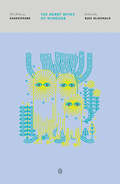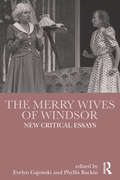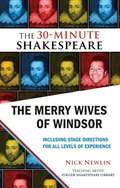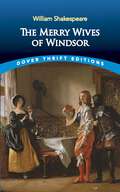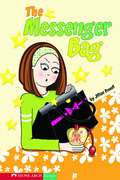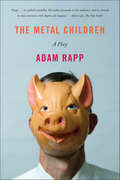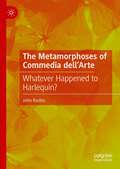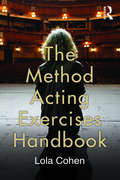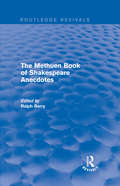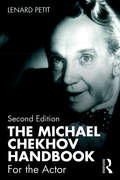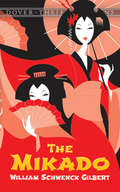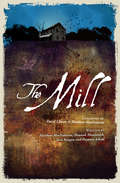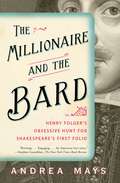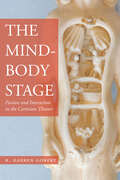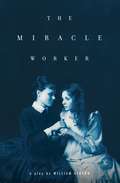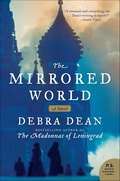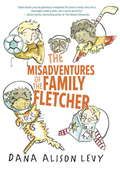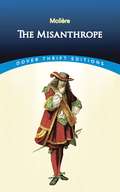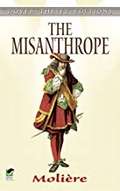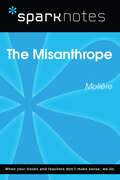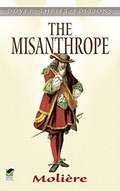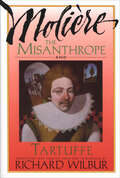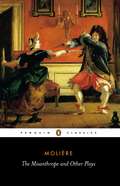- Table View
- List View
The Merry Wives of Windsor (Modern Library Classics)
by William Shakespeare Jonathan Bate Eric Rasmussen"Why, then the world's mine oyster."--The Merry Wives of Windsor Eminent Shakespearean scholars Jonathan Bate and Eric Rasmussen provide a fresh new edition of this popular comedy of love, laughter, and merriment--along with more than a hundred pages of exclusive features, including * an original Introduction to The Merry Wives of Windsor* incisive scene-by-scene synopsis and analysis with vital facts about the work* commentary on past and current productions based on interviews with leading directors, actors, and designers* photographs of key RSC productions* an overview of Shakespeare's theatrical career and chronology of his plays Ideal for students, theater professionals, and general readers, these modern and accessible editions from the Royal Shakespeare Company set a new standard in Shakespearean literature for the twenty-first century.From the Trade Paperback edition.
The Merry Wives of Windsor (SparkNotes Literature Guide Series)
by SparkNotesThe Merry Wives of Windsor (SparkNotes Literature Guide) by William Shakespeare Making the reading experience fun! Created by Harvard students for students everywhere, SparkNotes is a new breed of study guide: smarter, better, faster. Geared to what today's students need to know, SparkNotes provides: *Chapter-by-chapter analysis *Explanations of key themes, motifs, and symbols *A review quiz and essay topicsLively and accessible, these guides are perfect for late-night studying and writing papers
The Merry Wives of Windsor (The Pelican Shakespeare)
by William Shakespeare Russ Mcdonald Stephen Orgel A. R. BraunmullerThe acclaimed Pelican Shakespeare series edited by A. R. Braunmuller and Stephen Orgel The legendary Pelican Shakespeare series features authoritative and meticulously researched texts paired with scholarship by renowned Shakespeareans. Each book includes an essay on the theatrical world of Shakespeare’s time, an introduction to the individual play, and a detailed note on the text used. Updated by general editors Stephen Orgel and A. R. Braunmuller, these easy-to-read editions incorporate over thirty years of Shakespeare scholarship undertaken since the original series, edited by Alfred Harbage, appeared between 1956 and 1967. With definitive texts and illuminating essays, the Pelican Shakespeare will remain a valued resource for students, teachers, and theater professionals for many years to come. For more than seventy years, Penguin has been the leading publisher of classic literature in the English-speaking world. With more than 1,700 titles, Penguin Classics represents a global bookshelf of the best works throughout history and across genres and disciplines. Readers trust the series to provide authoritative texts enhanced by introductions and notes by distinguished scholars and contemporary authors, as well as up-to-date translations by award-winning translators.
The Merry Wives of Windsor: New Critical Essays (Shakespeare Criticism)
by Phyllis Rackin Evelyn GajowskiThe Merry Wives of Windsor has recently experienced a resurgence of critical interest. At times considered one of Shakespeare’s weaker plays, it is often dismissed or marginalized; however, developments in feminist, ecocritical and new historicist criticism have opened up new perspectives and this collection of 18 essays by top Shakespeare scholars sheds fresh light on the play. The detailed introduction by Phyllis Rackin and Evelyn Gajowski provides a historical survey of the play and ties into an evolving critical and cultural context. The book’s sections look in turn at female community/female agency; theatrical alternatives; social and theatrical contexts; desire/sexuality; nature and performance to provide a contemporary critical analysis of the play.
The Merry Wives of Windsor: The 30-Minute Shakespeare
by Nick NewlinPlanning a school or amateur Shakespeare production? The best way to experience the plays is to perform them, but getting started can be a challenge: The complete plays are too long and complex, while scene selections or simplified language are too limited."The 30-Minute Shakespeare" is a new series of abridgements that tell the "story" of each play from start to finish while keeping the beauty of Shakespeare's language intact. Specific stage directions and character suggestions give even inexperienced actors the tools to perform Shakespeare with confidence, understanding, and fun!This cutting of THE MERRY WIVES OF WINDSOR begins with one of Shakespeare's favorite fat knights, Sir John Falstaff, announcing his intention to woo both Mistress Ford and Mistress Page simultaneously, to the delight of his cohorts Bardolph, Pistol, and Nym, who then decide to double-cross Falstaff. The characters' movements on stage are clearly denoted so that even inexperienced actors can give the scenes life: Robin is nearsighted, Bardolph is a drunk who tries to juggle, and Pistol and Nym are constantly jostling for position. Other key moments include the hilarious wooing of Mistress Ford by Falstaff and the hysterical concealment of Falstaff in the laundry basket. The cutting ends in the woods with Falstaff dressed as a stag, being tormented by fairies for his comeuppance.The edition also includes an essay by editor Nick Newlin on how to produce a Shakespeare play with novice actors, and notes about the original production of this abridgement at the Folger Shakespeare Library's annual Student Shakespeare Festival.
The Merry Wives of Windsor: Webster's German Thesaurus Edition (Dover Thrift Editions)
by William ShakespeareAccording to legend, Queen Elizabeth I was so delighted with the character of Sir John Falstaff in Henry IV, Parts I and II, that she commanded Shakespeare to create a romantic comedy depicting the jolly old rogue in love. The obedient playwright responded with The Merry Wives of Windsor, a lively and enduring farce that offers a humorous rebuff to lechery and hypocrisy. Falstaff, whose greed and vanity overwhelm his good sense, determines to seduce a pair of well-to-do country housewives. The portly knight meets his match among the gentlewomen of Windsor, however, who counter his every stratagem with witty maneuvers of their own that expose Sir John's tomfoolery to public mirth. Familiar Shakespearean themes and devices -- romance, jealousy, disguises, and mistaken identities -- enrich the plot, along with a sparkling cast of supporting characters, including rival wooers, informers, and witty go-betweens.This madcap romp has been a favorite of readers and playgoers for over 400 years. Students, teachers, and all lovers of literature and drama will appreciate this inexpensive edition of an ageless comic gem.
The Messenger Bag
by Jillian Powell Charlotte AlderStacey finds a beautiful old bag. She takes it everywhere. She soon finds a secret hidden in the bag that's meant only for her.
The Metal Children: A Play
by Adam RappA play about a banned book, a small town, and fiction’s power to both divide and unite, from the “prodigiously talented” Pulitzer Prize finalist (Charles Isherwood, Variety).In small-town America, a young adult novel about teen pregnancy is banned by the local school board, igniting a fierce and violent debate over abortion, religious beliefs, and modern feminism. The decade-old novel’s directionless New York City author arrives in town to defend the book and finds that it has inspired a group of local teens to rebel in strange and unexpected ways. A timely and unforgettable drama about the failure of urban and heartland America to understand each other, The Metal Children explores what happens when fiction becomes a matter of life and death.Acclaim for Adam Rapp“An original . . . a distinctive voice.” —Michael Kuchwara, Associated Press“An oblique and haunting style reminiscent of Haruki Murakami’s best fiction.” —Ed Park, The Village Voice“Rapp is a latter-day incarnation of Sam Shepard.” —John Lahr, The New Yorker
The Metamorphoses of Commedia dell’Arte: Whatever Happened to Harlequin?
by John RudlinThe Metamorphoses of Commedia dell’Arte traces the steps by which Commedia has been transformed by cultural contact outside Italy into popular forms which bear little resemblance to the original. The book follows the Masks of Arlecchino, Pedrolino and Pulcinella as they gradually migrate and mutate into Harlequin, Mr. Punch and seaside Pierrot troupes. What happened to Pantalone, Scaramouche, Colombina and the male Lover is also investigated, though they had no final forms of their own. This study constitutes a history of what happened, notably in France and Great Britain, to a supremely popular theatrical genre as a result of changing fashions in entertainment brought on by societal developments, civil and industrial revolution and dynastic change. It investigates how the genre was exploited by management, and even its own stars, lost its vitality and gradually ended up in ‘sunken’ forms.
The Method Acting Exercises Handbook
by Lola CohenThe Method Acting Exercises Handbook is a concise and practical guide to the acting exercises originally devised by Lee Strasberg, one of the Method's foremost practitioners. The Method trains the imagination, concentration, senses and emotions to ‘re-create’ – not ‘imitate’ – logical, believable and truthful behavior on stage and in film. Building on nearly 30 years of teaching internationally and at the Lee Strasberg Theatre and Film Institute in New York and Los Angeles, Lola Cohen details a series of specific exercises in order to provide clear instruction and guidance to this preeminent form of actor training. By integrating Strasberg's voice with her own tried and tested style of teaching, Cohen demonstrates what can be gained from the exercises, how they can inform and inspire your learning, and how they might be applied to your acting and directing practice. As a companion to The Lee Strasberg Notes (Routledge 2010), a transcription of Strasberg's own teaching, The Method Acting Exercises Handbook offers an unparalleled and updated guide to this world renowned technique.
The Methuen Book of Shakespeare Anecdotes
by Ralph BerryFew playwrights have been more slandered, abused or honoured in performance than William Shakespeare. First published in 1992, this collection of 300 stories focuses on Shakespeare’s plays on stage. Organised chronologically, it offers the reader the opportunity to witness the changes in theatrical approaches to Shakespeare from their own time to the present day. This book will be of interest to those studying theatre, but also to those fascinated by the Shakespeare tradition.
The Michael Chekhov Handbook: For the Actor
by Lenard PetitThe Michael Chekhov Handbook is a practical guide to Chekhov’s supportive techniques for actors, fully updated with new exercises that examine the relationship between the sensations of the physical body and the imagination. Lenard Petit draws on 25 years of teaching experience to unlock and illuminate Michael Chekhov’s philosophy, and offers guiding principles and effective tools that actors can apply in rehearsal and performance. The second edition focuses on the building blocks of drama and an exploration of the five senses as an expressive springboard, with a new section on the function of the Archetype in the Chekhov method. Theory and practice are treated here with clarity and simplicity. Dedicated to students and teachers of acting, The Michael Chekhov Handbook provides readers with the essential tools they need to put the rewarding principles of this technique into use.
The Mikado (Dover Thrift Editions: Plays Ser.)
by William Schwenck GilbertA lighthearted burlesque of Victorian English culture and the vagaries of love, The Mikado offers an ideal matching of William Schwenck Gilbert's elegant comedic gifts with Arthur Sullivan's agile and refined musicianship. The tale unfolds amid a fanciful version of Japanese society, in which a wandering minstrel has the misfortune to fall in love with the beautiful ward of the Lord High Executioner of Titipu.The sparkling lyrics and witty dialogue of this comic masterpiece are as much a delight to read as they are to hear with musical accompaniment. The complete libretto is reprinted in this edition from the standard performance text of The Mikado, complete with nine charming illustrations drawn by W. S. Gilbert himself.
The Mill
by Daryl Cloran Matthew Macfadzean Hannah Moscovitch Tara Beagan Damien AtkinsIt's 1854 at the start of Now We Are Brody. The mill is boarded up as the townsfolk attempt to bury a dark shame from their past, but the arrival of a young woman with the deed to the mill threatens to unearth its secret. In The Huron Bride it is 1834 and Hazel Sheehan has braved the perilous journey across the Atlantic to work as a hired hand at her cousin's sawmill. When her cousin James asks her to marry him, Hazel is overjoyed, but will the ghost of James's ex-wife spoil their wedding plans? The mill does not yet exist in The Woods, and the land is the site of a First Nations burial ground. The interactions between the First Nations people and the first settlers put the wheel in motion for the terror that will haunt this area for hundreds of years to come. In part four, Ash, the mill stands: battered and surrounded by ash. Inside, five young people cling to life. Can hope take root on such poisoned ground?
The Millionaire and the Bard
by Andrea MaysToday it is the most valuable book in the world. Recently one sold for over five million dollars. It is the book that rescued the name of William Shakespeare and half of his plays from oblivion. The Millionaire and the Bard tells the miraculous and romantic story of the making of the First Folio, and of the American industrialist whose thrilling pursuit of the book became a lifelong obsession.When Shakespeare died in 1616 half of his plays died with him. No one--not even their author--believed that his writings would last, that he was a genius, or that future generations would celebrate him as the greatest author in the history of the English language. By the time of his death his plays were rarely performed, eighteen of them had never been published, and the rest existed only in bastardized forms that did not stay true to his original language. Seven years later, in 1623, Shakespeare's business partners, companions, and fellow actors, John Heminges and Henry Condell, gathered copies of the plays and manuscripts, edited and published thirty-six of them. This massive book, the First Folio, was intended as a memorial to their deceased friend. They could not have known that it would become one of the most important books ever published in the English language, nor that it would become a fetish object for collectors. The Millionaire and the Bard is a literary detective story, the tale of two mysterious men--a brilliant author and his obsessive collector--separated by space and time. It is a tale of two cities--Elizabethan and Jacobean London and Gilded Age New York. It is a chronicle of two worlds--of art and commerce--that unfolded an ocean and three centuries apart. And it is the thrilling tale of the luminous book that saved the name of William Shakespeare "to the last syllable of recorded time."
The Mind-Body Stage: Passion and Interaction in the Cartesian Theater
by R. Darren GobertDescartes's notion of subjectivity changed the way characters would be written, performed by actors, and received by audiences. His coordinate system reshaped how theatrical space would be conceived and built. His theory of the passions revolutionized our understanding of the emotional exchange between spectacle and spectators. Yet theater scholars have not seen Descartes's transformational impact on theater history. Nor have philosophers looked to this history to understand his reception and impact. After Descartes, playwrights put Cartesian characters on the stage and thematized their rational workings. Actors adapted their performances to account for new models of subjectivity and physiology. Critics theorized the theater's emotional and ethical benefits in Cartesian terms. Architects fostered these benefits by altering their designs. The Mind-Body Stage provides a dazzlingly original picture of one of the most consequential and confusing periods in the histories of modern theater and philosophy. Interdisciplinary and comparatist in scope, it uses methodological techniques from literary study, philosophy, theater history, and performance studies and draws on scores of documents (including letters, libretti, religious jeremiads, aesthetic treatises, and architectural plans) from several countries.
The Miracle Worker: A Play
by William GibsonNO ONE COULD REACH HER Twelve-year-old Helen Keller lived in a prison of silence and darkness. Born deaf, blind, and mute, with no way to express herself or comprehend those around her, she flew into primal rages against anyone who tried to help her, fighting tooth and nail with a strength born of furious, unknowing desperation. Then Annie Sullivan came. Half-blind herself, but possessing an almost fanatical determination, she would begin a frightening and incredibly moving struggle to tame the wild girl no one could reach, and bring Helen into the world at last....
The Mirrored World: A Novel
by Debra DeanThe critically acclaimed author of The Madonnas of Leningrad (“Elegant and poetic, the rare kind of book that you want to keep but you have to share” —Isabel Allende), Debra Dean returns with The Mirrored World, a breathtaking novel of love and madness set in 18th century Russia. Transporting readers to St. Petersburg during the reign of Catherine the Great, Dean brilliantly reconstructs and reimagines the life of St. Xenia, one of Russia’s most revered and mysterious holy figures, in a richly told and thought-provoking work of historical fiction that recounts the unlikely transformation of a young girl, a child of privilege, into a saint beloved by the poor.
The Misadventures of the Family Fletcher
by Dana Alison LevyMeet the Fletchers. <P><P>Their year will be filled with new schools, old friends, a grouchy neighbor, hungry skunks, leaking ice rinks, school plays, wet cats, and scary tales told in the dark! <P><P> There's Sam, age twelve, who's mostly interested in soccer, food, and his phone; Jax, age ten, who's psyched for fourth grade and thinks the new neighbor stinks, and not just because of the skunk; Eli, age ten (but younger than Jax), who's thrilled to be starting this year at the Pinnacle School, where everyone's the smart kid; and Frog (not his real name), age six, who wants everyone in kindergarten to save a seat for his invisible cheetah. Also Dad and Papa. <P><P>WARNING: This book contains cat barf, turtle pee, and some really annoying homework assignments. Perfect for fans of The Penderwicks and James Patterson's Middle School series, this seriously funny, modern family adventure features two dads, four adopted boys, and a variety of pets.
The Misanthrope
by MolièreMolière understood profoundly what makes us noble, pathetic, outrageous and funny, and in his splendid comedies satirized human folly to perfection. One of the best of his plays — and one of the greatest of all comedies — is The Misanthrope, first performed in 1666, when the King of France himself had assumed patronage of Molière's company, and the actor/playwright was at the height of his career.Spotlighting the absurdities of social and literary pretension, The Misanthrope shows us a man who is quick to criticize the hypocrisies, inconsistencies and faults of others, yet remains blind to his own. As "the misanthrope" grows more and more irritable with others, the play becomes more and more entertaining, even as a happy ending for the hero seems less and less likely.
The Misanthrope
by Molière Richard WilburMolière understood profoundly what makes us noble, pathetic, outrageous and funny, and in his splendid comedies satirized human folly to perfection. One of the best of his plays — and one of the greatest of all comedies — is The Misanthrope, first performed in 1666, when the King of France himself had assumed patronage of Molière's company, and the actor/playwright was at the height of his career. Spotlighting the absurdities of social and literary pretension, The Misanthrope shows us a man who is quick to criticize the hypocrisies, inconsistencies and faults of others, yet remains blind to his own. As "the misanthrope" grows more and more irritable with others, the play becomes more and more entertaining, even as a happy ending for the hero seems less and less likely.
The Misanthrope (SparkNotes Literature Guide Series)
by SparkNotesThe Misanthrope (SparkNotes Literature Guide) by Moliere Making the reading experience fun! Created by Harvard students for students everywhere, SparkNotes is a new breed of study guide: smarter, better, faster. Geared to what today's students need to know, SparkNotes provides: *Chapter-by-chapter analysis *Explanations of key themes, motifs, and symbols *A review quiz and essay topicsLively and accessible, these guides are perfect for late-night studying and writing papers
The Misanthrope And Other Plays: A New Selection
by Molière John Wood David CowardMolière understood profoundly what makes us noble, pathetic, outrageous and funny, and in his splendid comedies satirized human folly to perfection. One of the best of his plays — and one of the greatest of all comedies — is The Misanthrope, first performed in 1666, when the King of France himself had assumed patronage of Molière's company, and the actor/playwright was at the height of his career. <p><p> Spotlighting the absurdities of social and literary pretension, The Misanthrope shows us a man who is quick to criticize the hypocrisies, inconsistencies and faults of others, yet remains blind to his own. As "the misanthrope" grows more and more irritable with others, the play becomes more and more entertaining, even as a happy ending for the hero seems less and less likely.
The Misanthrope And Tartuffe
by MolièreThe Pulitzer Prize winner’s classic translations of Moliere’s comic masterpieces satirizing shallowness, self-righteousness, and hypocrisy.The Misanthrope is a searching comic study of falsity, shallowness, and self-righteousness through the character of Alceste, a man whose conscience and sincerity are too rigorous for his time. In Tartuffe, a wily, opportunistic swindler manipulates a wealthy prude and bigot through his claims of piety. This latter translation earned Wilbur a share of the Bollingen Translation Prize for his critically acclaimed work of this satiric take on religious hypocrisy.In brilliant rhymed couplets, Pulitzer Prize-winning poet Richard Wilbur renders two of seventeenth-century French playwright Moliere's comic masterpieces into English, capturing not only the form and spirit of the language but also its substance.“Mr. Wilbur has given us a sound, modern, conversational poetry and has made Moliere’s The Misanthrope brilliantly our own.” —The New York Times Book Review“Richard Wilbur’s translation of Tartuffe is a continuous delight from beginning to end.” —Pulitzer Prize and National Book Award–winning poet Richard Eberhart
The Misanthrope and Other Plays
by Jean-Baptiste MoliereIn the seventeenth century, Molière raised comedy to the pitch of great art and, three centuries later, his plays are still a source of delight. He created a new synthesis from the major comic traditions at his disposal. This collection demonstrates the range of Molière's comic vision, his ability to move between the broad and basic ploys of farce to the more subtle and sophisticated level of high comedy. The Misanthrope appears along with Such Preposterously Precious Ladies, Tartuffe, A Doctor Despite Himself, The Would-Be Gentleman, and Those Learned Ladies.
